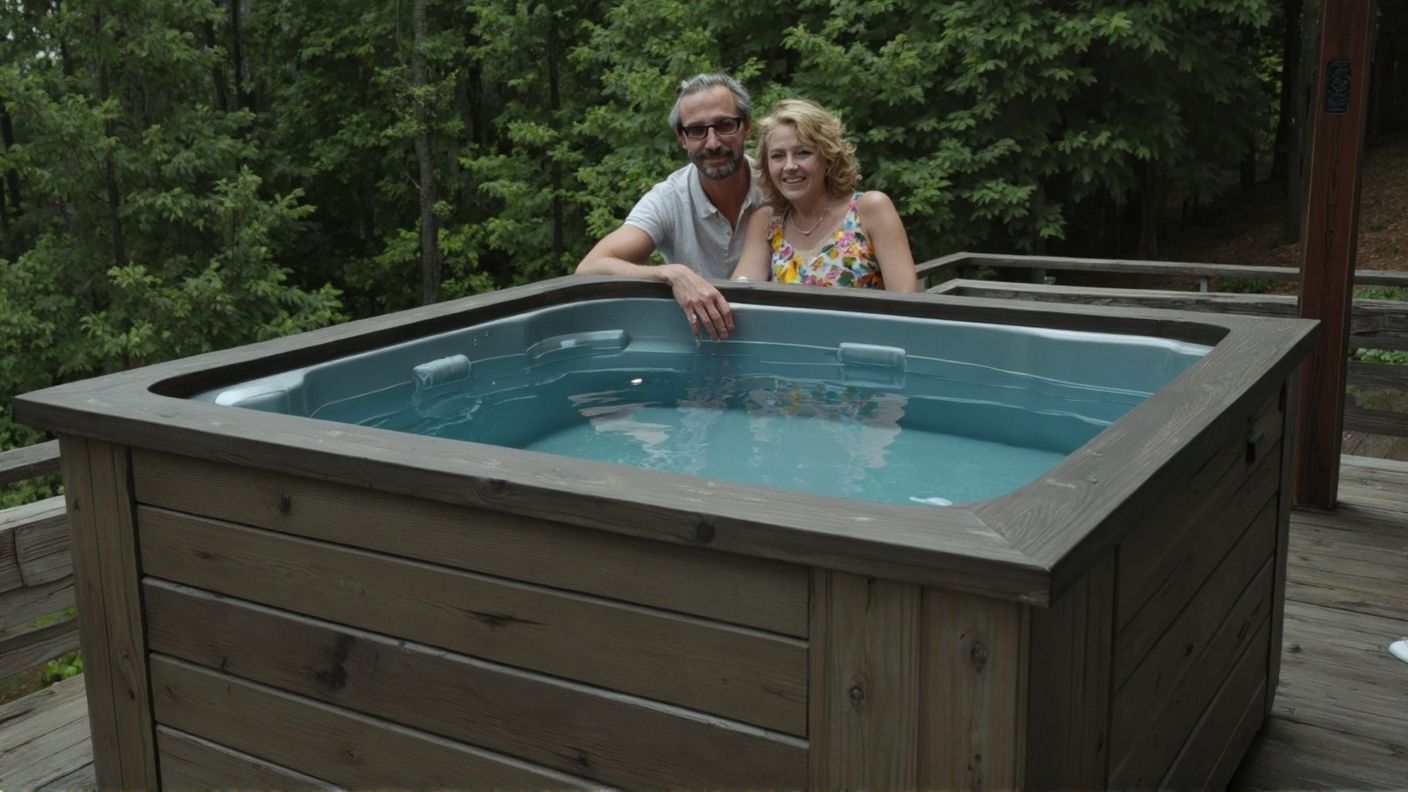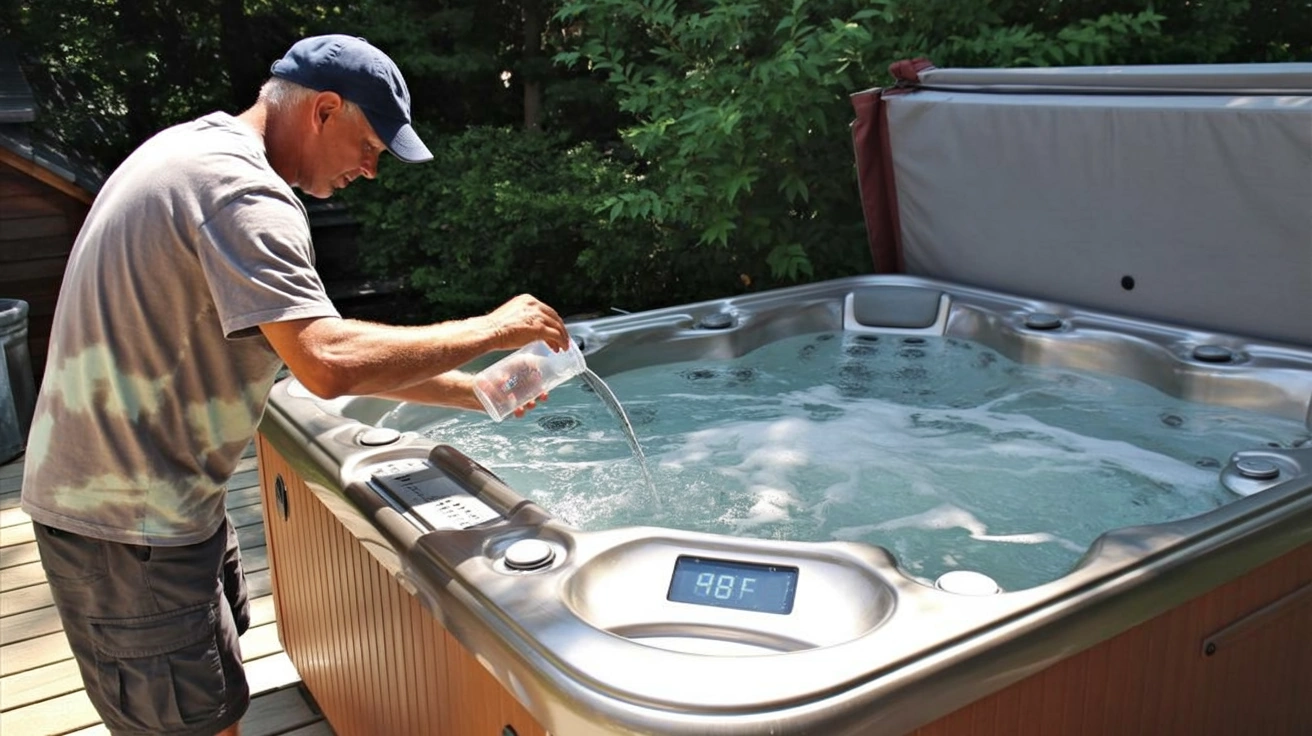Hot tub natural enzymes promise to reduce your chemical use while keeping spa water crystal clear. Many hot tub owners wonder do hot tub enzymes work?
Hot tub enzymes do work, but not as a replacement for traditional sanitizers like chlorine or bromine. So they should be used in conjunction with sanitizers.
These enzyme products effectively break down body oils, dead skin, and organic material that cause cloudy water and scum lines.
The real benefit is reducing your chemical use by 25-50% while maintaining better water clarity. Enzymes handle the organic waste products that traditional sanitizers struggle with, allowing less chlorine to work more effectively.
However, enzymes provide no actual sanitizing power against harmful bacteria. You’ll still need regular sanitizers for safety, but you can use significantly less of those harsh chemicals.
This combination approach reduces skin irritation, chemical smells, and maintenance headaches for many hot tub owners. The key is understanding exactly what enzymes can and cannot do for your spa water.
This guide reveals which enzyme products deliver real results, how much you can actually reduce chemical use, and whether the cost savings justify the investment. You’ll learn the optimal way to combine enzymes with traditional sanitizers for the cleanest, most comfortable hot tub experience possible.
How do natural enzymes work in a hot tub?
Natural enzymes work by breaking down organic material in your spa water through simple chemical reactions. These special proteins target body oils, dead skin, and other organic waste products that build up from regular use.
Enzymes split large organic molecules into smaller pieces that your hot tub filters can easily remove. This process eliminates the organic contaminants that cause cloudy water, scum lines, and unpleasant odors without harsh chemicals.
The warm water actually helps enzymes work better at breaking down organic compounds. Unlike traditional sanitizers, enzymes don’t kill bacteria but instead eat up the non-living organic matter that feeds harmful germs.
When enzymes remove these organic particles, your sanitizer works better at lower levels. This means you can use less chlorine while keeping clean water and better water clarity.
The process happens all the time as enzymes stay active in your spa water for days or weeks. They keep working to break down new organic material as people add body oils and other organic substances when they soak.
This ongoing action reduces the organic load on your hot tub filters and stops chloramine formation that causes chemical smells and skin irritation.
Are enzymes better than chlorine or bromine in a hot tub?
Enzymes are not better than chlorine or bromine because they serve completely different purposes in spa water. Hot tub enzymes cannot provide actual sanitizing power to kill harmful bacteria and viruses that make water unsafe.
Chlorine and bromine are essential traditional sanitizers that destroy dangerous microorganisms on contact. Without these chemicals, your hot tub becomes a breeding ground for illness-causing germs that enzymes cannot eliminate.
However, enzyme products excel at breaking down organic material like body oils and dead skin that cause cloudy water and scum lines. This gives enzymes a clear advantage for improving water clarity and reducing chemical smells.
The best approach combines both systems for maximum benefits. Use enzymes to handle organic waste products while maintaining chlorine at 1-2 ppm instead of the usual 3 ppm, or bromine at 2-3 ppm instead of 5 ppm.
This combination allows you to use 30-50% less chlorine or bromine while achieving better results than either method alone. Hot tub owners get reduced skin irritation and significant chemical savings without sacrificing water safety.
Enzymes work continuously to break down organic contaminants, making your sanitizer more effective at lower doses. The result is cleaner spa water with fewer harsh chemicals and a more enjoyable hot tub experience overall.
Ready to Spend Less Time On Maintenance and More Time Enjoying Your Hot Tub?
Let’s face it. Balancing the water, cleaning filters, dealing with rashes, and trying to figure out which chemicals to buy and add can make you feel more like a chemist than someone who just wants to relax after a long hard day!
That’s exactly why The Hot Tub Handbook and Video Course is so valuable!
This is from Matt over at Swim University and he developed it for people looking to save money, time, and frustration. His tips on chemicals can save you $100/year just by making sure you buy only what you need.
So if you’re ready to stop being confused or frustrated with your hot tub and start spending more time in it, check out The Hot Tub Handbook and Video Course.
Just click that link to learn more on their website.
If I use enzymes in a hot tub, do I still have to use sanitizer or shock?
Yes, you absolutely must continue using sanitizer and shock even with hot tub enzymes in your spa water. Enzymes provide zero actual sanitizing power against harmful bacteria, viruses, and other dangerous microorganisms.
Hot tub enzymes only break down organic material like body oils, dead skin, and other organic waste products. They cannot kill the germs that cause serious illness and infections in warm water environments.
You still need chlorine or bromine as your primary sanitizer to destroy harmful bacteria on contact.
However, enzymes allow you to use less chlorine – typically 1-2 ppm instead of 3 ppm, or reduce bromine levels by 30-50%.
Occasional shock treatments remain essential for eliminating chloramine formation and breaking down organic contaminants that build up over time. Enzymes help reduce how often you need to shock, but they cannot replace this important step entirely.
The combination approach gives hot tub owners the best results – enzymes handle organic particles while traditional sanitizers kill germs. This reduces skin irritation and chemical smells while maintaining safe water chemistry.
How to use hot tub enzymes
Add hot tub enzymes directly to your spa water with the circulation pump running to ensure proper mixing. Most enzyme products require 1-2 ounces per 400 gallons of water for the initial dose.
For first-time use, add enzymes after balancing your water chemistry but before adding traditional sanitizers. This allows the enzymes to start breaking down existing organic material like body oils and dead skin immediately.
Continue your regular maintenance schedule with reduced sanitizer levels – typically 30-50% less chlorine or bromine than normal. The enzymes handle organic waste products while your sanitizer kills harmful bacteria.
Add enzymes weekly or bi-weekly depending on your hot tub’s usage and the specific product instructions. Heavy use requires more frequent enzyme treatments to manage the increased organic load.
Never replace your sanitizer entirely with enzyme products since they provide no actual sanitizing power. Always maintain proper chlorine or bromine levels for safe water.
Clean your hot tub filters more frequently when using enzymes as they help break down more organic contaminants. This improves water clarity and prevents filter clogging from increased organic particles.
Monitor your spa water regularly and adjust enzyme dosing based on bather load and water quality results.
Should you use enzymes in your hot tub?
You should use hot tub enzymes if you want to reduce chemical use while improving water clarity and comfort. Most hot tub owners benefit from the reduced skin irritation and better water quality that enzyme products provide.
Pros of Using Hot Tub Enzymes
- Use 30-50% less chlorine or bromine while maintaining clean water
- Significantly reduce skin irritation and chemical smells
- Improve water clarity by breaking down body oils and dead skin
- Keep hot tub filters cleaner for longer periods
- Handle heavy use situations more effectively than traditional sanitizers alone
- Reduce scum lines and cloudy water problems
Cons of Using Hot Tub Enzymes
- Add $15-30 monthly cost to your hot tub maintenance routine
- Provide no actual sanitizing power against harmful bacteria
- Require consistent weekly dosing for best results
- Take time to show noticeable improvements in spa water
- May not be necessary for light usage with few bathers
Skip enzymes if your spa water stays consistently clear and you don’t experience problems with normal levels of chlorine. For heavy use situations with multiple daily bathers, enzymes become almost essential for managing the increased organic material and maintaining a comfortable hot tub experience.
What are the best hot tub enzymes?
The MAV AquaDoc Natural Enzyme Hot Tub Cleaner is Amazon’s best-selling enzyme product and delivers excellent results for most hot tub owners. This concentrated formula effectively breaks down body oils, dead skin, and other organic material that cause water clarity problems.
Hot tub owners consistently report reduced skin irritation and the ability to use less chlorine when using AquaDoc enzymes. The product works continuously to eliminate organic waste products that traditional sanitizers struggle to handle.
Other top-rated enzyme products include Spa Perfect and Spa Marvel, which offer similar benefits for spa water maintenance. These natural enzyme treatments help reduce chemical smells and keep hot tub filters cleaner longer.
Choose enzyme products that specifically target organic contaminants rather than generic pool enzymes. The best hot tub enzymes are concentrated formulas that require smaller doses, making them more cost-effective for regular maintenance.
CLICK HERE to check the current price on the MAV AquaDoc Natural Enzyme Hot Tub Cleaner on Amazon.
Final Thoughts
Hot tub enzymes work effectively when used alongside traditional sanitizers, not as replacements. The chemical savings and reduced skin irritation make them worthwhile for most hot tub owners who want to use less chlorine.
Your spa experience improves significantly with cleaner filters, better water clarity, and fewer chemical smells. Enzymes excel at breaking down organic contaminants that cause scum lines and cloudy water issues.
Remember that enzyme products require no actual sanitizing power – you still need chlorine or bromine for safety. The best way forward is combining both approaches for optimal results.
Start with a quality enzyme treatment during your weekly maintenance routine. You’ll quickly notice the difference in water quality and reduced chemical presence.
For most people, the benefits justify the additional cost through improved comfort and lower sanitizer usage. Your hot tub maintenance becomes easier while creating a more enjoyable soaking environment for everyone.
Ready to Spend Less Time On Maintenance and More Time Enjoying Your Hot Tub?
Let’s face it. Balancing the water, cleaning filters, dealing with rashes, and trying to figure out which chemicals to buy and add can make you feel more like a chemist than someone who just wants to relax after a long hard day!
That’s exactly why The Hot Tub Handbook and Video Course is so valuable!
This is from Matt over at Swim University and he developed it for people looking to save money, time, and frustration. His tips on chemicals can save you $100/year just by making sure you buy only what you need.
So if you’re ready to stop being confused or frustrated with your hot tub and start spending more time in it, check out The Hot Tub Handbook and Video Course.
Just click that link to learn more on their website.
As an Amazon Associate, I may earn a small commission from qualifying purchases if you click on Amazon from my site and choose to make a purchase. You can read my complete affiliate disclosure for more details.
- Do Hot Tub Enzymes Work? (Better Than Chemicals?) - July 28, 2025
- How Do You Know if Your Hot Tub Sanitizer is Working? - July 28, 2025
- Do I Need to Put Algaecide in My Hot Tub? - July 27, 2025







